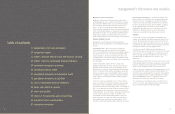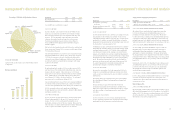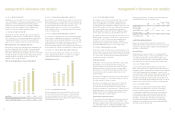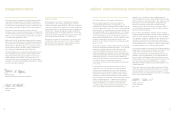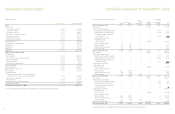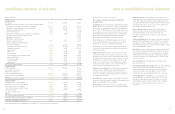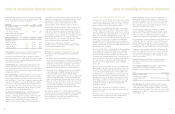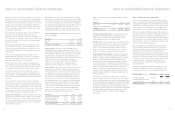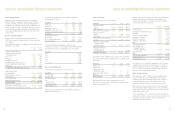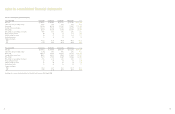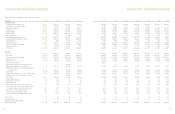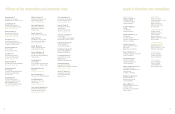Nordstrom 2004 Annual Report Download - page 20
Download and view the complete annual report
Please find page 20 of the 2004 Nordstrom annual report below. You can navigate through the pages in the report by either clicking on the pages listed below, or by using the keyword search tool below to find specific information within the annual report.
Income Taxes: We use the asset and liability method of accounting
for income taxes. Using this method, deferred tax assets and liabilities
are recorded based on differences between financial reporting and tax
basis of assets and liabilities. The deferred tax assets and liabilities
are calculated using the enacted tax rates and laws that are expected
to be in effect when the differences are expected to reverse. We
establish valuation allowances for tax benefits when we believe it is
not likely that the related expense will be deductible for tax purposes.
Other current liabilities: The following table shows the components of
other current liabilities:
Fiscal Year 2004 2003
Gift cards $133,532 $109,324
Other 220,669 205,429
Total other current liabilities $354,201 $314,753
Loyalty Program: Customers who reach a cumulative purchase
threshold when using our Nordstrom private label cards or our co-
branded Nordstrom VISA credit cards receive merchandise certificates.
These merchandise certificates can be redeemed in our stores similar
to a gift certificate. We estimate the net cost of the merchandise
certificate that will be ultimately earned and redeemed by the customer
and record this cost as the customer earns the merchandise
certificates. The cost of the loyalty program is not significant in
relation to the corresponding sales, so the program expense is
recorded in cost of sales rather than as a reduction of net sales.
Vendor Allowances: We receive allowances from merchandise vendors
for purchase price adjustments, cooperative advertising programs,
cosmetic selling expenses, and vendor sponsored contests. Purchase
price adjustments are recorded as a reduction of cost of sales at the
point they have been earned and the related merchandise has been
sold. Allowances for cooperative advertising programs and vendor
sponsored contests are recorded in cost of sales and selling, general
and administrative expenses as a reduction to the related cost when
incurred. Allowances for cosmetic selling expenses are recorded in
selling, general and administrative expenses as a reduction to the
related cost when incurred. Any allowances in excess of actual costs
incurred that are recorded in selling, general and administrative
expense are recorded as a reduction to cost of sales. The following
table shows vendor allowances earned during the year:
Fiscal Year 2004 2003 2002
Purchase price adjustments $47,707 $49,312 $42,777
Cosmetic selling expenses 96,936 88,518 79,794
Cooperative advertising 57,786 44,939 41,309
Vendor sponsored contests 3,975 4,180 3,734
Total vendor allowances $206,404 $186,949 $167,614
notes to consolidated financial statements
Leases: We recognize lease expense on a straight-line basis over the
initial lease term. In 2004, we corrected our lease accounting policy
to recognize lease expense, net of landlord reimbursements, from the
time that we control the leased property. In the past, we recorded net
rent expense once lease payments or retail operations started. We
recorded a charge of $7,753 ($4,729 net of tax) in the fourth quarter
of 2004 to correct this accounting policy. The impact of this change
was immaterial to prior periods.
We lease the land or the land and building at many of our Full-Line
stores, and we lease the building at many of our Rack stores.
Additionally, we lease office facilities, warehouses and equipment.
Most of these leases are classified as operating leases and they expire
at various dates through 2080. We have no significant individual or
master lease agreements.
Our fixed, noncancelable terms of the lease generally are 20 to 30
years for Full Line stores and 10 to 15 years for Rack stores. Many
of our leases include options that allow us to extend the lease term
beyond the initial commitment period, subject to terms agreed to at
lease inception.
For leases that contain predetermined, fixed escalations of the
minimum rentals, we recognize the rent expense on a straight-line
basis and record the difference between the rent expense and the
rental amount payable under the leases in liabilities.
Most of our leases also provide for payment of operating expenses,
such as common area charges, real estate taxes and other executory
costs. Some leases require additional payments based on sales and
are recorded in rent expense when the contingent rent is probable.
Leasehold improvements made at the inception of the lease are
amortized over the shorter of the asset life or the initial lease term
as described above. Leasehold improvements made during the lease
term are also amortized over the shorter of the asset life or the initial
lease term.
We receive incentives to construct stores in certain developments.
These incentives are recorded as a deferred credit and recognized as
a reduction to rent expense on a straight-line basis over the lease term
as described above. At the end of 2004 and 2003, this deferred credit
balance was $392,807 and $407,856. We also receive incentives based
on a percentage of a store’s net sales and recognize these amounts in
the year that they are earned as a reduction to rent expense.
Foreign Currency Translation: The assets and liabilities of our foreign
subsidiaries have been translated to U.S. dollars using the exchange
rates effective on the balance sheet date, while income and expense
accounts are translated at the average rates in effect during the year.
The resulting translation adjustments are recorded in accumulated
other comprehensive earnings.
notes to consolidated financial statements
Allowances were recorded in our consolidated statement of earnings
as follows:
Fiscal Year 2004 2003 2002
Cost of sales $106,902 $55,161 $44,379
Selling, general and administrative
expense 99,502 131,788 123,235
Total vendor allowances $206,404 $186,949 $167,614
Fair Value of Financial Instruments: The carrying amounts of cash
equivalents and short term-investments approximate fair value.
See Note 11 for the fair values of our long-term debt, including
current maturities and interest rate swap agreements.
Derivatives Policy: We use derivative financial instruments to manage
our interest rate and foreign currency exchange risks. Our derivative
financial instruments for our interest rate lock and our foreign
currencies are not material to our financial condition or results of
operations and we have no material off-balance sheet credit risk.
See Note 11 for a further description of our interest rate swaps.
Recent Accounting Pronouncements: In November 2004, the FASB
issued SFAS No. 151, “Inventory Costs an amendment of ARB No. 43,
Chapter 4.” SFAS No. 151 amends ARB No. 43, Chapter 4, “Inventory
Pricing” to clarify that abnormal amounts of idle facility expense,
freight, handling costs, and wasted material should be recognized
as current period charges. In addition, this statement requires that
fixed overhead production costs be allocated to conversion costs based
on the normal capacity of the production facilities. SFAS No. 151 is
effective for inventory costs incurred during fiscal years beginning
after June 15, 2005, and should be applied prospectively. We do not
believe the adoption of SFAS No. 151 will have a material impact on
our financial statements.
In December 2004, the FASB issued SFAS No. 123R, “Share-Based
Payment.” SFAS No. 123R requires us to measure the cost of employee
services received in exchange for an award of equity instruments based
on the grant-date fair value of the award. That cost will be recognized
over the period during which an employee is required to provide services
in exchange for the award. We have not yet quantified the effects of
the adoption of SFAS No. 123R, but it is expected that the new standard
will result in significant stock-based compensation expense. SFAS
No. 123R will be effective for our third fiscal quarter beginning
July 31, 2005.
Note 2: Cumulative Effect of Accounting Change
In 2002, we adopted SFAS No. 142, “Goodwill and Other Intangible
Assets,” which revised the accounting and reporting requirements for
goodwill and other intangible assets. Under SFAS No. 142, goodwill
and intangible assets having indefinite lives are no longer amortized
but are subject to annual impairment tests. Our intangible assets
were determined to be either goodwill or indefinite lived tradename.
We have three reporting units that we evaluate. At the beginning of
2002, we had $133,436 of intangibles associated with our Façonnable
Business Unit, which is one level below our reportable Retail Stores
segment. The purchase of the minority interest of Nordstrom.com LLC
in the first quarter of 2002 resulted in additional goodwill of $24,178,
of which $8,462 was allocated to the Retail Stores reporting unit and
$15,716 to the Catalog/Internet reporting unit.
We test our intangible assets for impairment by comparing the fair
value of the reporting unit with its carrying value. Fair value was
determined using a discounted cash flow methodology. We perform
our impairment test annually during our first quarter or when
circumstances indicate we should do so. Our initial impairment test
of the Façonnable Business Unit resulted in an impairment charge to
tradename of $16,133 and to goodwill of $5,767. These impairments
resulted from a reduction in management’s estimate of future growth
for this reporting unit. The impairment charge is reflected as a
cumulative effect of accounting change. No further impairments
have occurred to date.
The following table shows the actual results of operations as well as
pro-forma results adjusted to exclude the cumulative effect of the
accounting change in 2002. There was no impact to 2004 or 2003.
Fiscal year 2002 Net earnings Earnings per share
Basic Diluted
Reported net earnings $90,224 $0.67 $0.66
Cumulative effect of accounting
change, net of tax 13,359 0.10 0.10
Adjusted net earnings $103,583 $0.77 $0.76
37
36


